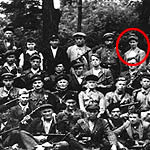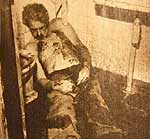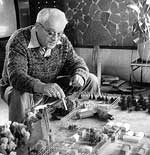Dutch version >>>
German version >>>
French version >>>
a 35 mm film documentary directed
by Lily van den Bergh & Pavel Kogan
The film
History and outline of the situation
The Uprising
The protagonists
Photo Gallery
TrailerSobibor, Poland
Ultra- secret extermination camp where about a quarter of a million Jews were murdered.
47 survived.'Revolt in Sobibor' captures historically on film the audacious plan and subsequent, successful massive camp breakout, shattering the myth of the Jews being led as ‘lambs to the slaughter’.
Sobibor, like Bełzec and Treblinka, was one of the Nazi extermination camp as part of Operation Reinhardt: from 1942-1943 some 250,000 died there before Hitler ordered it to be razed to the ground following the revolt of 1943, led by Russian Red Army officer Alexander Pecherski.The film
Four years in the making, and filmed in Russia, Brazil, the USA, The Netherlands, Poland, Germany and Australia, this documentary features four of the survivors of the revolt and Jules Schelvis:
Alexander 'Sasha' Pecherski Rostov on Don, Soviet Union Stanislav Szmajzner Goiania, Brazil Samuel Lerer New York, USA Regina Zielinski Sidney, Australia Jules Schelvis * Tricht, The Netherlands * Sole survivor of a transport of 3006 Dutch Jews, Jules Schelvis stayed only a few hours in Sobibor and did not witness the revolt. He survived nine forced labour camps working as a printer. After the war he wrote ‘Sobibor: A History of a Nazi Death Camp’, considered to be the best scientific book on the subject.
After a group of Jewish Russian POW arrived in Sobibor September 1943, it took only 22 days before Red Army officer Alexander Pecherski and Polish inmate Leon Feldhendler organised a revolt. It was a daring plan. Every Nazi was to be killed at his post, silently. Then the weapons were to be seized, the gate stormed.
October 14 a massive camp breakout took place. Once out, there were two possibilities: either the Nazis would catch you and kill you, or the anti-German, anti-Russian, anti-Semitic Polish partisans would catch you and probably kill you. The odds were heavily stacked against the rebelling prisoners. It was a revolt of the dead.
They knew that they would never make it, but there were two things in favour of the action: '… even if it was only one SS-man. We were determined and sure, that we were going to take some of them with us' and the second argument was irrational hope: miracles are few, but they do happen. The four featured survivors of the Sobibor Revolt owe their lives to miracles.
Not 'just another film on the holocaust', but an encounter with people who survived hell to make their peace with life. Harrowing events are recorded, but no footage of actual violence is used. Instead there are memories tinged with humour and tears, there are songs and music.
The redemption of human dignity.
''The film manages to convey the sense of people in their own right, not just figures who got in the way of history... A memorable picture and an important historic document.''
(Variety 1989)
''A most memorable picture. It is the first Dutch-Soviet co-production. The directors Lily Van den Bergh for the Dutch, Pavel Kogan for the Russian side. Just as memorable because it is the first film about the holocaust which is not mainly pamphlet or lament.
As Van den Bergh puts it: 'This is no sad picture, we did not want to show what had been done to these people, objects of a mad system, but how they, the subjects revolted and survived. They never stopped surviving.' The hellish memories are there. Just under the skin. But there is, near to the surface, also music, and laughter. And there is hope. The hope of justice, of happiness, albeit delayed, of quietness, albeit unstable.
……. What the film does miraculously well is to show that these are individuals, separate entities, even if they share traumatic experiences. It shows that life relentlessly goes on. There is no stopping to it. The four tell horrific stories, harrowing things, unbelievable cruelties. But they live, tenaciously, avidly. They are gluttons for life. They even love. They even make plans.''
Gerry Waller (Dutch Film 1989)History and outline of the situation
20 January 1942, in the second year of the Second World War, fifteen German party officials met in Berlin under the chairmanship of Reinhardt Heydrich with orders to discuss the practical problems of the ‘Endlösung der Judenfrage’. This meeting found its place in the history books as the Wannsee Conference. The upshot was that SS-Generalleutenant der Polizei Globocnik received orders that all Jews under German control should be killed, in so far as possible, in secret. To this end, he had three extermination camps constructed, far from the Western world, in Poland: Treblinka in the Warsaw district, Belzec and Sobibor in the Lublin district. The killing of the Jews was to be carried out by means of gassing in specially built ‘shower units’.
The extermination camp in Sobibor became operative in April 1942, only a matter of months after the Wannsee Conference. The camp covered an area of about 60 hectares and offered a cheerful prospect to new arrivals with its curtained windows and flower-pots. It was divided into five sections.
Camp I was the part where the people selected to be put to work, the so-called ‘Arbeitsjuden’, were housed and where the cobblers, tailors and other barracks were situated. The Arbeitsjuden had to keep the whole death factory in working order.
Camp II was the section where the unsuspecting victims had to hand their belongings. A little further on they were to undress altogether. This was the section where clothes and shoes were sorted afterwards.
In Camp III were the gas chambers and the sites where the bodies were at first buried and later cremated. The Arbeitsjuden who worked in this section had no contact whatsoever with the other sections.
Camp IV housed the ammunition seized from the Russians, where it was cleaned by prisoners selected for this work. The ‘Vorlager’ was the part of Sobibor where roughly 40 SS-men and 250 Ukrainian guards lived. It contained the SS-kitchen, the canteen, the arms depot and the garage. The whole camp was surrounded by three layers of barbed wire with a wide ditch in between, and a minefield round the other perimeter. Watch towers with armed Ukrainians could register the slightest movement in and outside the camp.
Most of the SS-men in this death factory had already made their mark as killers of their fellow men. Between 1939-41, many of them had been working in T4, the code name for an organisation which took care of the gassing of mentally-handicapped people in what the Germans called ‘Heilanstalten’ such as Hartheim, Hadamar and Kalmenhof. The guards were so-called ‘Volksdeutsche’ from the Ukraine. They were referred to as Hiwis, ‘Hilfsfreiwillige’ or ‘voluntary helpers’ of the guards
According to official Polish sources, 250,000 Jews were gassed in Sobibor, most of them were Poles. But human shipments arrived from many other countries such as Czechoslovakia, France, Austria, Russia and the Netherlands. In the period from the beginning of March till the end of July 1943, nineteen trains left Westerbork in Holland for Sobibor, carrying a total of 34,313 Jews.
top
Revolt in Sobibor
Introduction
The film
History and outline of the situation
The Uprising
The protagonists
Photo GalleryThe Uprising
For a long time there had been a secret underground committee among the Arbeitsjuden in Sobibor, headed by Leon Feldhendler, which had been planning escapes. There were occasional individual escapes not initiated by the committee, but there had been no large-scale breakout attempt.
However, on 23 September 1943, a group of Russian Jews arrived in the camp as military prisoners. Because a planned escape had just been discovered among some Dutch inmates, all Dutch prisoners, 72 in number, were shot in reprisal. Now the German camp commander needed a new group of Arbeitsjuden to replace them.
Among the eighty Russians selected was Sasha (Alexander) Pecherski, a lieutenant of the Red Army, who had been captured and who was subsequently discovered to be Jewish. It took Pecherski no more than twenty-two days to become acquainted with the situation in the camp and to make detailed plans for an uprising, which did indeed take place under his leadership on 14 October 1943. His audacious plan consisted of first killing the SS-men, thus crippling the organisation, then taking a regular roll-call and leaving the camp en masse. The plan did not totally succeed, but of the 600 prisoners, 3-400 of them managed to leave the camp. Only 47 of them survived until the end of the war. Most of them were captured by the Germans, betrayed by farmers in the neighbourhood in trade for sugar or killed by anti-Semitic Polish partisans. Those who had remained behind, all those in Camp III and those who were either unwilling or unable to escape were executed immediately after the uprising.
Soon afterwards, a small transport of thirty Jews arrived from Treblinka to raze the camp to the ground. When this task had been completed they too were executed. Feldhendler was murdered in Lublin short after the war. Pecherski returned to the Soviet Union where he lived with his wife in Rostov-on-Don until his death in 1990 at the age of 81.
A monument, a short stretch of railway and a large hill of human ashes are all that remain of the extermination camp of Sobibor.
top
Revolt in Sobibor
Introduction
The film
History and outline of the situation
The Uprising
The protagonists
Photo GalleryLife of Alexander Pecherski
Dealing with the past
Life of Regina Zielinski
Life of Samuel Lerer
Life of Stanislaw Szmajzner
Life of Jules Schelvis
After the war Alexander Pecherski appeared as a witness during the Soviet trial of 11 former Ukrainian guards at Sobibor; all of whom were convicted.
Stanislaw Szmajzner was a member of a group dedicated to hunting out Nazis in Brazil and was involved in tracing henchmen Stangl and Wagner. He identified Wagner in a police-station in Rio de Janeiro and hinted that he was involved in Wagner's ‘suicide’. He was a important witness in the West-German Sobibor trials in Frankfort and Hagen.
Samuel Lerer recognised the ‘Gasmaster’ of Sobibor, Erich Bauer in Berlin, and fetched the police. Bauer was arrested. His arrest and prosecution was the first in a series of trials of Sobibor war criminals through which Sobibor was given public attention for the first time.
Jules Schelvis began to write. His research on Sobibor resulted in a meticulously written monography: Vernietigingskamp Sobibor (Sobibor: A History of a Nazi Death Camp) of 1993. Thanks to Schelvis's thorough archival work his book is considered to be the best scientific book on the subject.
Trailer


